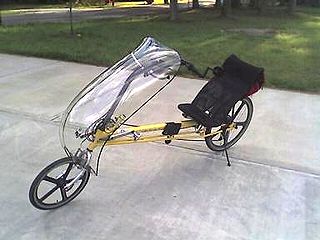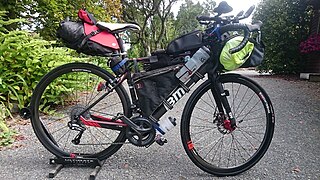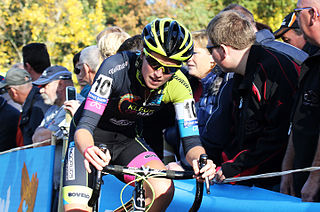Related Research Articles

A bicycle, also called a pedal cycle, bike, push-bike or cycle, is a human-powered or motor-assisted, pedal-driven, single-track vehicle, with two wheels attached to a frame, one behind the other. A bicycle rider is called a cyclist, or bicyclist.

A recumbent bicycle is a bicycle that places the rider in a laid-back reclining position. Some recumbent riders may choose this type of design for ergonomic reasons: the rider's weight is distributed comfortably over a larger area, supported by back and buttocks. On a traditional upright bicycle, the body weight rests entirely on a small portion of the sitting bones, the feet, and the hands.

In a road bicycle race, the peloton is the main group or pack of riders. Riders in a group save energy by riding close to other riders. The reduction in drag is dramatic; riding in the middle of a well-developed group, drag can be reduced to as little as 5–10%. Exploitation of this potential energy saving leads to complex cooperative and competitive interactions between riders and teams in race tactics. The term is also used to refer to the community of professional cyclists in general.

The Race Across America, or RAAM, is an ultra-distance road cycling race held across the United States that started in 1982 as the Great American Bike Race.

A racing bicycle, also known as a road bike is a bicycle designed for competitive road cycling, a sport governed by and according to the rules of the Union Cycliste Internationale (UCI).
Cycle sport is competitive physical activity using bicycles. There are several categories of bicycle racing including road bicycle racing, cyclo-cross, mountain bike racing, track cycling, BMX, and cycle speedway. Non-racing cycling sports include artistic cycling, cycle polo, freestyle BMX, mountain bike trials, hardcourt bike polo and cycleball. The Union Cycliste Internationale (UCI) is the world governing body for cycling and international competitive cycling events. The International Human Powered Vehicle Association is the governing body for human-powered vehicles that imposes far fewer restrictions on their design than does the UCI. The UltraMarathon Cycling Association is the governing body for many ultra-distance cycling races.

Road bicycle racing is the cycle sport discipline of road cycling, held primarily on paved roads. Road racing is the most popular professional form of bicycle racing, in terms of numbers of competitors, events and spectators. The two most common competition formats are mass start events, where riders start simultaneously and race to a set finish point; and time trials, where individual riders or teams race a course alone against the clock. Stage races or "tours" take multiple days, and consist of several mass-start or time-trial stages ridden consecutively.

A cyclocomputer, cycle computer, cycling computer or cyclometer is a device mounted on a bicycle that calculates and displays trip information, similar to the instruments in the dashboard of a car. The computer with display, or head unit, usually is attached to the handlebar for easy viewing. Some GPS watches can also be used as display.

John Howard is an Olympic cyclist from the United States, who set a land speed record of 152.2 miles per hour (245 km/h) while motor-pacing on a pedal bicycle on July 20, 1985 on Utah's Bonneville Salt Flats. This record was beaten in 1995 by Fred Rompelberg.

This is a glossary of terms and jargon used in cycling, mountain biking, and cycle sport.

A cycling power meter is a device on a bicycle that measures the power output of the rider. Most cycling power meters use strain gauges to measure torque applied, and when combined with angular velocity, calculate power.
Pete Penseyres was the winner of the bicycle Race Across America, or RAAM, in 1984 and 1986, setting a world record of 3107 miles (5000 km) in 8 days, 9 hours, and 47 minutes. His average speed of 15.40 miles per hour (24.8 km/h) was the record for 27 years, finally being broken by Christoph Strasser in 2013, who averaged 15.58 miles per hour. Penseyres trained for years by cycling 65 miles to work each day.

Bicycle performance is measurable performance such as energy efficiency that affect how effective a bicycle is. Bicycles are extraordinarily efficient machines; in terms of the amount of energy a person must expend to travel a given distance, cycling is calculated to be the most efficient self-powered means of transportation.

The following outline is provided as an overview of and topical guide to bicycles:

TerraCycle, Inc. is a designer and manufacturer of recumbent bicycle parts based in Portland, Oregon in the United States. TerraCycle is known for its idlers and Cargo Monster load-carrying extensions.
Jonkheer Sebastiaan Bowier is a Dutch cyclist.

Bikepacking is how a bicycle is packed for bicycle touring. As with backpacking, lightweight packing is a popular topic within bicycle packing. Any kind of bicycle can be used for bikepacking, and specialized touring bicycles often have attachment points from the factory such as low riders and luggage carriers, but most types of bicycles can be equipped with a frame bag, saddle bag, top tube bag and handlebar bag.
The hour record is the record for the longest distance cycled in one hour on a bicycle from a stationary start. Cyclists attempt this record alone on the track without other competitors present. It is considered perhaps the most prestigious record in all of cycling. Over history, various cyclists ranging from unknown amateurs to well-known professionals have held the record, adding to its prestige and allure. There are several records, one of which is the record for streamlined human powered vehicles, also known as recumbent bicycles.

Motor doping, or mechanical doping, in competitive cycling terminology, is a method of cheating by using a hidden motor to help propel a racing bicycle. The term is an analogy to chemical doping in sport, cheating by using performance-enhancing drugs. As a form of "technological fraud" it is banned by the Union Cycliste Internationale, the international governing body of cycling.
References
- 1 2 "HPV's Across America: RAAM Tests More Than Technology". Archived from the original on 2009-08-25. Retrieved 2009-05-04.
- ↑ HPV DIVISION (4-man relay teams) Archived 2008-12-24 at the Wayback Machine
- ↑ "Ultra Cycling". Archived from the original on 2012-02-23. Retrieved 2009-05-08.
- 1 2 Training Smart Archived 2009-05-16 at the Wayback Machine
- ↑ "Chris Kostman". Archived from the original on 2015-05-31. Retrieved 2009-05-01.
- ↑ Rainer Pivit
- ↑ "Leonard W. Brownlie" (PDF). Archived (PDF) from the original on 2011-01-01. Retrieved 2009-05-01.
- 1 2 3 4 5 "Race Across America". Archived from the original on 2016-01-30. Retrieved 2009-04-30.
- ↑ Handlebar-mounted fairings
- ↑ 1989 Race Across America results Archived 2008-12-24 at the Wayback Machine
- ↑ ".Search Lightning Cycle Dynamics". Archived from the original on 2008-12-23. Retrieved 2009-04-30.